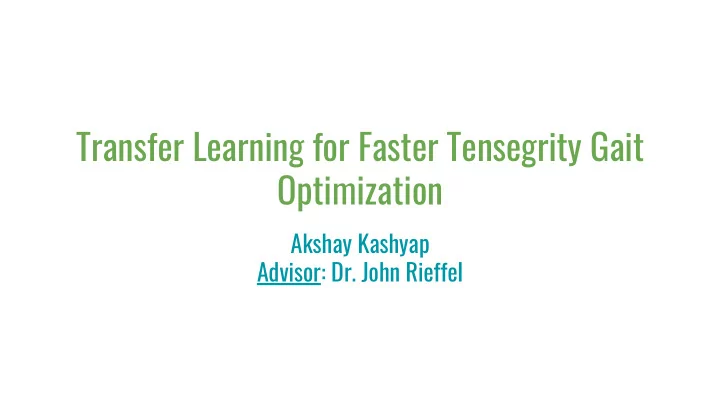

Transfer Learning for Faster Tensegrity Gait Optimization Akshay Kashyap Advisor: Dr. John Rieffel
Question: Tensegrity Robots can use Machine Learning to learn how to move efficiently. Can we make them learn better and faster, especially in new, unseen conditions?
Proposed Solution: Use Transfer Learning, a subfield of Machine Learning, to have the robots use previous learning experiences to adapt better and learn faster.
0. Background
0.1 Tensegrity Robots A class of soft robots composed of intertwined springs and rigid struts. ● Tensegrity = Tens ile + Int egrity ●
0.1 Tensegrity Robots Can carry payloads in the center and can be dropped from heights. ● NASA exploring use for planetary missions. ●
0.1 Tensegrity Robots Can be made to move using vibrations from attached motors. ● Tensegrity Gait = Configuration of Motors ● Gait = (m 1 , m 2 , …, m n ), where n = No. of Motors and m i = (phase, frequency, amplitude) Gait Performance = Speed / Distance Travelled / ... ●
0.2 Bayesian Optimization A Sequential Model-based Optimization (SMBO) algorithm for optimizing ● expensive functions using a Gaussian Process. Works by evaluating the function systematically at different points and ● trying to update it’s prediction of what the function looks like at each step.
0.2 Bayesian Optimization Bayesian Optimization can be used to train a Tensegrity Robot Gait to ● move make it move as fast as possible.
0.2 Bayesian Optimization Bayesian Optimization can be used to train a Tensegrity Robot Gait to ● move make it move as fast as possible. Problem: Needs to be trained in every new environment and abnormal ● state the robot is deployed in.
0.2 Bayesian Optimization Bayesian Optimization can be used to train a Tensegrity Robot Gait to ● move make it move as fast as possible. Problem: Needs to be trained in every new environment and abnormal ● state the robot is deployed in. (Proposed) Solution: Use Transfer Learning. ●
0.3 Transfer Learning Transfer learning = Improvement of learning in a new task using knowledged from related task that has been learned previously. [2]
0.3 Transfer Learning Source Task = Task that has been previously learnt ● Target Task = New task to learn ● Use Source Task to improve learning in Target Task ●
0.4 Proposed Solution Use Transfer Learning along with Bayesian Optimization. ● Framework proposed by T.T Joy, et. al. [3] ● Model observations from source task as noisy outputs of target task: ● Modify the Gaussian Process to incorporate this noise during ● optimization.
1. Tools
1.1 Tensegrity Simulation Homegrown C++ and ODE-based Tensegrity physics simulator. ● Models struts as capsule and springs as forces following Hooke’s Law. ● Models each motor as a perpendicular force applied periodically at points ● along the circumference of the strut.
1.1 Tensegrity Simulation Altitude Time
1.3 Bayesian Optimization and Transfer Learning ● Used the Python PyGPGO library for Bayesian Optimization. Re-engineered it to implement the ● Transfer Learning framework.
2. Methodology
2.1 Simulator + Optimizer System The optimizer program communicates with the simulator using Sockets . ● ● Optimizer sends out gaits to evaluate. Simulator evaluates and sends back performance of the gait.
2.2 Experiment ● Perform the optimization process for Source Task , Target Task without Transfer Learning , and Target Task with Transfer Learning . Perform n = 50 optimization cycles for each task. Perform 10 experiments. ● Plain Ground Hilly Terrain
3. Results
3.1 Learning Improvement
3.1.1 Experiment 1 - Difference in Gravity and Friction ● Source Task : ○ Gravity = -0.1 ○ Friction = 0.5 ● Target Task : ○ Gravity = -0.5 ○ Friction = 0.75 ● 40 Optimization Trials ● Metric: Max Speed Achieved ● 10% Improvement
3.1.1 Experiment 2 - Flat vs. Hilly Terrain ● Source Task : ○ Flat Surface ○ Gravity = -0.1 ○ Friction = 0.5 ● Target Task : ○ Hilly Surface ○ Gravity = -0.1 ○ Friction = 0.75 ● 60 Optimization Trials ● Metric: Max Speed Achieved ● 12.1% Improvement
3.2 Learnt Gaits
3.2.1 Experiment 1 - Difference in Gravity and Friction M1 - M2 M2 - M3 M1 - M3 Source Task Target Task Target + TL
3.2.2 Experiment 2 - Flat vs. Hilly Terrain M1 - M2 M2 - M3 M1 - M3 Source Task Target Task Target + TL
3.3 Statistical Significance Using Mann–Whitney U test Experiment 2 Experiment 1 Max Speed Achieved Max Speed Achieved p-value < 0.01 p-value < 0.05 99% Confidence Interval 95% Confidence Interval
4. Conclusion
4.1 Conclusion In conclusion, my research shows that previous learning experiences indeed can be leveraged to improve new learning tasks for Tensegrity Robots in the context of locomotion.
4.2 References [1] John Rieffel and Jean-Baptiste Mouret. Adaptive and resilient soft tensegrity robots. Soft Robotics , page (to appear), 2018. arXiv preprint arXiv:1702.03258. [2] Lisa Torrey and Jude Shavlik (2009). Transfer Learning. In Handbook of Research on Machine Learning Applications . 2009. [3] Joy T.T., Rana S., Gupta S.K., Venkatesh S. (2016) Flexible Transfer Learning Framework for Bayesian Optimisation. In Advances in Knowledge Discovery and Data Mining . PAKDD 2016.
May the force be with you!
Recommend
More recommend